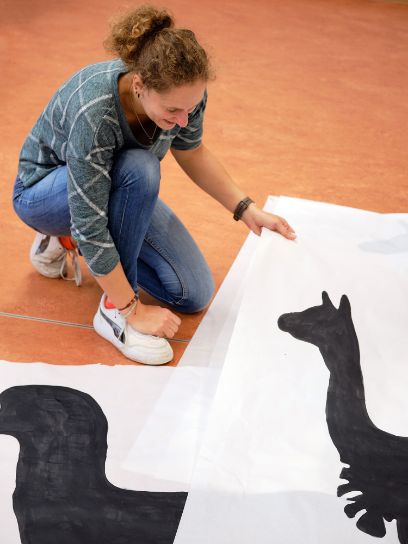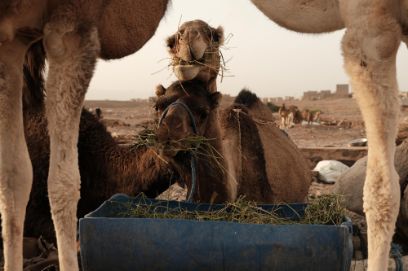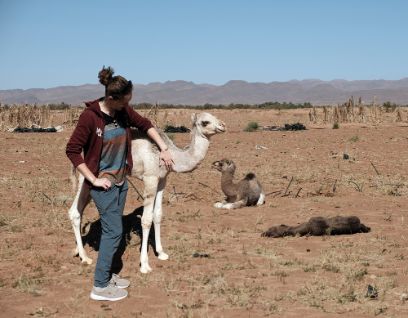- News
Celebrate Camelids Week
23.09.2024 A corridor of wall art, an exhibition in the foyer and a Brown Bag Lunch are all part of HAFL’s celebrations for the 2024 International Year of Camelids.
How tall is a dromedary? What does a vicuña look like? The corridor outside the labs and a display in the foyer can answer these and other questions about the camelid family – bactrians, dromedaries, llamas, guanacos, alpacas, and vicuñas.
Camelids Week at HAFL runs from 7–11 October: Cecchini Institute colleagues Nancy Bourgeois, Pascale Waelti, Célia Bühler, Micha Fournier and Sarah Guidi had the idea to celebrate this year’s International Year of Camelids by doing something fun.

Sarah, a research assistant in Food Science & Management, was happy to take on the challenge to paint six life-size wall hangings.
“When we talked about doing an exhibition, we thought life-size camels on these walls would be cool,” Sarah said. “As a teenager, I’d used the same technique to paint Bruce Springsteen on my bedroom door (laughs) and thought this was an interesting way to compare how big camelids are.”
For those who want more than just the visual experience, a Brown Bag Lunch on Wednesday 9 October offers a deeper dive into camels and camel-milk production. Sarah and her supervisor, Pascale, will present the Camilk project from 12-1pm in room B.4.13 and online.
Manifesting a project
For Sarah, working on the Camilk project, which assesses the potential of camel-milk products and camel feed from agricultural waste in Morocco, feels like a dream come true. After visiting a friend living there in 2016 and again in 2022, and being impressed by the land and its people, she was inspired to find a way to connect her expertise in food science with a project that could benefit Moroccan nomads.
“After that second trip, I knew I wanted to do something with this energy,” she said. “I brainstormed with my friend in Morocco about how I could link my studies in food science with Morocco. I didn’t target camels specifically – I was looking at argan nut side-stream valorisation as I was working with plant proteins’ extraction – and she told me about camel-milk valorisation. After reading about argan, I found that the side stream is beneficial for camel-milk quality and quantity. Then I thought that’s how I could link both things.”
Just one year later, Sarah and the HAFL team’s Camilk project proposal, to conduct an extended value chain analysis of the needs and production challenges for camel-milk stakeholders, was awarded a Leading House MENA Research Partnership Grant. HAFL Food Business lecturer Guillaume Egli, Pascale and Sarah conducted a scoping trip earlier this year, working with partners from the Polydisciplinary Faculty of Taroudant at Ibn Zohr University in Morocco.
“It’s an amazing opportunity,” Sarah said. “I never imagined I’d be working on a project with camels, but this topic is really cool. The nomads have nothing and give you everything when you go to their home, so to be able to work on a project that gives back is amazing. What I like most is this research feels useful.”

Improving livelihoods
The project focuses on producing camel milk in Morocco for local consumption, not export, and on improving nomads’ livelihoods by improving camel health. “We’re still in the scoping phase, looking to see if this project can really work,” Sarah said. “Camel milk is known to be hypoallergenic; it doesn’t contain Beta-lactoglobulin, the protein in cow’s milk that causes allergies in some people. The milk has a lot of ingredients that can fight infections, and it’s better suited for warm countries because it doesn’t spoil as quickly.”
However, the project isn’t without its challenges. “Camel milk doesn’t coagulate as easily as cow’s milk, so it’s harder to ferment for products like yoghurt. We haven’t started any actual trials in Morocco yet. Right now, we only have frozen camel milk, and freezing changes its techno-functionalities. The perfect scenario would be to work with raw milk, but that’s difficult.”
Despite these hurdles, Sarah remains optimistic. “If it were easy, it wouldn’t be a research project!” she said with a laugh. The ultimate goal is to create camel milk products like yoghurt and cheese, but much needs to be done before this can become a reality, from securing funding to sourcing local milk suppliers.
Drought and nutrition
Camels have long been integral to life in Morocco, particularly in regions where the climate is harsh and resources are scarce. They can survive in extreme conditions where other livestock, such as cattle, would struggle. “Camels can eat almost anything, even cactus needles, without damaging their mouths,” Sarah said. “They’re used for transportation, meat and milk, and sometimes the fat from the bump is used to treat arthritis and rheumatism.”

But dealing with drought means the camels are not as healthy or producing as much milk as the herders would like. Finding a way to use food waste to create nutrient-rich camel feed is also a part of the Camilk project.
“Because of the drought, nomads have to buy food for their camels, and they have to spend more money than they’re used to,” Sarah said. “They would love to give their herd more nutritional feed so more milk can be produced. The milk currently produced is only used for the baby camels. Producing a cheaper feed that’s healthy would decrease the nomad’s spending and allow them to feed the camels more, so they would produce more milk which could then be sold.”
Using by-products from argan oil production, as well as the leaves from tomato and watermelon plants, are currently the focus. Argan is used in the beauty industry and very popular in Morocco. Adding argan cakes – the compacted leftovers once the oil has been extracted from the argan nut – into the camels’ diet would improve their health.
“Argan is very nutritious for camels,” Sarah said. “There’s a lot of potential for using argan waste to supplement camel feed. Developing a cheaper, more nutritious feed for the camels means creating a new revenue stream for these communities. The ultimate goal would be to set up a cooperative for women in Morocco, which would create jobs and opportunities for economic independence.”

---
Text by Angela Wade
Contacts:
Category: International